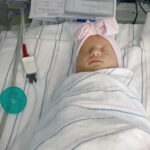Rowan the Remarkable: Defying the odds with CPAM

This is the story of a baby named Rowan and his remarkable journey of beating the odds after doctors discovered a potentially fatal mass on his lung in utero. This is also the story of his mother, Casey, who fought for him every step of the way, and the medical professionals whose collaboration and planning helped save his life.
Making a plan to beat the odds
Casey was a little more tired and weepier than she was carrying her daughter a couple of years earlier, but overall, the first half of her pregnancy with Rowan was uneventful. However, during her anatomy scan at about 19 weeks, things took a turn when the ultrasound showed a large mass on Rowan’s right lung, known as a congenital pulmonary airway malformation (CPAM). While most CPAMs are benign, some can become life-threatening if they grow too large and compress other organs. Rowan’s mass was large enough that it pushed on his heart, putting him at risk for a type of heart failure called hydrops, so Casey’s local prenatal team in Western Massachusetts referred her to Boston Children’s Maternal Fetal Care Center (MFCC) in affiliation with Brigham and Women’s Hospital.
“At one point, we were told that his chance of survival was 50-50,” Casey says. “It was so hard knowing it could go either way. For me, it was just listening to what he wanted and what he thought he needed, so we decided to take it week by week and see exactly what this little guy had in store for himself.”
Taking it week by week meant traveling to Boston Children’s regularly to evaluate how the CPAM was growing. The bigger it got, the more it pressed on Rowan’s healthy lung and shifted the position of his heart.
Dr. Alireza Shamshirsaz, the center’s director, was concerned that if the CPAM filled with oxygen at delivery, it could further compress Rowan’s lungs and heart. To avoid this, he decided it was best for Casey to have a cesarean section (C-section) procedure at Boston Children’s so pediatric surgeon Dr. Terry Buchmiller could remove the mass as soon as possible after Rowan arrived. This meant careful collaboration with Dr. Louise Wilkins-Haug, Casey’s maternal-fetal care specialist at Brigham and Women’s Hospital, and other members of Brigham and Women’s obstetrics team to ensure a safe delivery for Casey and immediate surgical care for Rowan.
In the room where it happened
Casey’s C-section procedure took place at Boston Children’s Hospital when she was about 38 weeks so Rowan could have immediate access to an operating room. Due to COVID-19 protocols, her family couldn’t be with her in the OR. Still, she felt loved and supported.

“The staff treated me like I was family,” Casey says. “My nurse, Nicole Peace, was with me during my procedure because my mom couldn’t be. She was amazing. Everyone in that surgery room was just phenomenal. And Kassie Merrill-Olver, my social worker, provided so many different resources. She gave us a tour of the neonatal intensive care unit (NICU) and gave me books for my older daughter. It was great. She was really awesome. I couldn’t have asked for a better team.”
Casey says she felt good during the procedure, and she was able to see Rowan briefly when he arrived. Immediately after, though, he was taken to an adjoining operating room for surgery, where Dr. Buchmiller performed a lung resection to remove the top two lobes of his right lung, eliminating the mass and allowing the bottom lobe to remain intact and function normally.
The successful outcome of the surgery was confirmed through a chest X-ray.
“His lung was doing exactly what it needed to do,” Casey says.
Rowan spent two weeks in the NICU for monitoring and care, where his progress exceeded all expectations. At three weeks old, Rowan was cleared to go home.
Creating a supportive community
Today, as he nears his first birthday, Rowan is healthy, happy, and surrounded by love. And Casey is forever grateful for the care they both received from the team in the MFCC.
Casey believes Rowan’s story has the power to help other families facing a diagnosis of CPAM. She knows firsthand how lonely and uncertain the experience can be.
“I felt like I was out there in the dark,” Casey says. She used hashtags like #cpam and #momofcpambaby to connect with others on social media but came up with few results. That’s why she hopes her story can provide solace and information to those going through similar challenges.
“I want people to be able to find people they can relate to who went through similar things,” Casey says. “And to let them know they don’t have to believe the odds are stacked against them.”
Learn more about the Maternal Fetal Care Center, in affiliation with Brigham and Women’s Hospital.
Related Posts :
-

‘I did it!’ Micah is thriving after maternal-fetal care for a CPAM
Dr. Marla Lipsyc-Sharf is no stranger to the field of medicine: As a medical oncology fellow, she’s familiar with ...
-

Years in the making: Team performs successful fetal intervention for VOGM
On an ordinary Wednesday in March, a team of specialists from two institutions made the extraordinary happen: a first-of-its-kind intervention ...
-

The sooner the better: An argument for fetal MRI before 16 weeks
To date, fetal magnetic resonance imaging (MRI) has been limited to the mid-second or the third trimester of pregnancy. This ...
-

I’ve been there, too: What my baby’s tumor taught me as a NICU nurse
I had a toddler at home when I found out I was pregnant with my twins, Hannah and Sophie. Since ...





